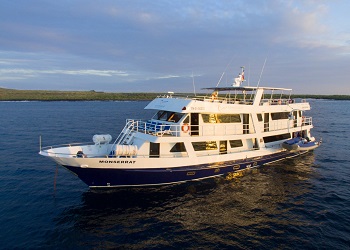Endemic Itinerary D - 4 days
ITINERARY D - 4 DAYS
THURSDAY
AM: Baltra: Arrival and Transfer to the boat
PM: Bartolome (HK/SN/PR)
FRIDAY
AM: Floreana: Cormorant Point / Devil's Crown (HK/SN/PR/KY)
PM: Floreana: Post Office Bay / Baroness’ Overlook (HK/SN/PR/KY)
SATURDAY
AM: Santiago: Chinese Hat (HK/SN/PR/KY)
PM: North Seymour (HK/SN/PR)
SUNDAY
AM: Santa Cruz: Black Turtle Cove (PR)
Baltra: Transfer to the Airport
HK: HIKE / SN: SNORKEL / PR: PANGA RIDE / KY: KAYAK /
PB: PADDLE BOARD
DAY 1: THURSDAY
AM: BALTRA ARRIVAL AND TRANSFER TO THE BOAT
Upon arrival, reception and assistance at the airport, transfer from Baltra Airport to the M/C Endemic.
PM: BARTHOLOME
After lunch, you will discover Bartholomew Island. Once here, you will ascend to admire the spectacular panorama of the Sullivan Bay and the famous Pinnacle Rock. The beaches at the foot of the Pinnacle Rock are excellent for snorkeling from which you can discover the marvelous underwater world, and with a little luck, you’ll get to snorkel with penguins.
Activities: dinghy ride, snorkeling & walking (1.2 mi/2km)
Type of landing: Wet landing
Difficulty: Easy
DAY 2: FRIDAY
AM: FLOREANA: DEVIL´S CROWN / CORMORANT POINT
In the morning, after breakfast, the first spot to be visited is Devil´s Crown that is an underwater volcanic crater, almost covered completely by Galapagos waters. Just a small portion of the rock formation can be seen from above and it looks like a crown. The underwater world is very rich in coral reefs, abundant marine species. Birds are also part of this visitor point due to its location in open waters.
Or visit Cormorant Point where you will land on a green olivine sand beach. Following a 100 meters long path you will soon reach a lagoon with flamingos.
Activities: Dinghy ride, snorkeling & walking.
Type of landing: Wet landing
Difficulty: Easy/ moderate
PM: FLOREANA: BARONESS’ LOOKOUT / POST OFFICE BAY
In the afternoon, you will visit the Baroness’ Lookout (Mirador de la Baronesa). This viewpoint is located on the north of Floreana Island. The way up and trail is very easy, steps are placed in this area for security. Your naturalist guide will tell the murder and mystery legend of the Baroness.
Or you will go to the Post Office Bay, which keeps the legendary post barrel that whalers historically used to post their mail in.
Activities: Short walk (less than 0.6mi/ 1km) & snorkeling.
Type of landing: Wet landing
Difficulty: Easy
(B, L, D)
DAY 3: SATURDAY
AM: SANTIAGO: CHINESE HAT
In the morning, after breakfast you will visit Chinese Hat, which is a small islet off the south coast of Santiago, with a maximum elevation of 160 feet (52 meters). Though within easy reach of Santa Cruz, Chinese Hat is typically only visited by those aboard a Galapagos Cruise.
Activities: Walking, snorkeling, kayaking, dinghy ride.
Type of landing: Wet landing
Difficulty: Easy
PM: NORTH SEYMOUR
In the afternoon, North Seymour island will be discovered. It is located slightly to the north of Baltra. It is a low, flat island, formed by submarine lava formation uplift. Covered with low, bushy vegetation, it contains the largest colony of magnificent frigate birds in the Galapagos. There is also a large population of blue-footed boobies that perform an amusing courtship dance when nesting conditions are right.
Activities: Walking, snorkeling, dinghy ride.
Type of landing: Dry landing
Difficulty: Moderate/ difficult
(B, L, D)
DAY 4: SUNDAY
AM: SANTA CRUZ: BLACK TURTLE COVE
After breakfast, enjoy the visit to Black Turtle Cove, which is located on the north shore of Santa Cruz. It is a living illustration of how mangroves alter the marine environment to create a rich and unique habitat. Three mangrove species crowd the area from the shore out into the lagoon, which reaches almost a mile inland.
As you drift through quiet waters in the dinghy, you are likely to see spotted eagle rays and diamond shaped mustard rays, which swim in a diamond formation. White-tipped reef sharks slip beneath the boat and Pacific green sea turtles come to the surface for air and to mate. Waterfowl, including pelicans, herons and egret, all feed in the cove. This is a peaceful place that will make you feel calm.
Activities: dinghy ride, snorkeling.
Type of landing: No landing
Difficulty: Easy
PM: BALTRA TRANSFER TO THE AIRPORT
After this last visit, transfer to Baltra airport for your return flight to mainland Ecuador.
Assistance and farewell at the airport.
(B, -, -)
***End of cruise***
* Itineraries are subject to change without prior notice due to weather conditions, National Park regulations, emergencies on board or any unforeseen situation.







